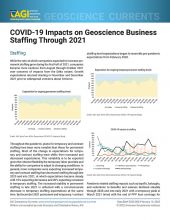The U.S. Bureau of Labor Statistics (BLS) uses the Standard Occupational Classification (SOC) system to categorize occupations at the federal level. We use BLS datasets to estimate employment projections, salaries, and the industries where geoscientists work, and we periodically re-assess the SOC categories used by the BLS to ensure we have a complete list of occupational categories that are representative of the geoscience workforce. Updates to the SOC occur roughly about every decade, and these updates can result in re-classification of occupations, including merging and disaggregation of existing occupational categories, as well as inclusion of new occupational categories. With the release of the new Employment Projections data this September, BLS began using the newest set of SOC categories from the recently released 2018 SOC. Currently there are 23 occupational categories that fall within the purview of the geoscience workforce, and these occupations fall into five broad categories: managers, engineers, scientists, technicians, and postsecondary teachers.
This year, in addition to re-assessing the list of SOC categories, we also examined changes to the proportion of broad occupational categories within the geoscience workforce to see how the composition of the profession has changed over the past 20 years. Most of the changes in the composition of the geoscience workforce has been in the proportion of scientists and technicians. The percentage of scientists increased from 31% to 37% between 1999 and 2019 while the percentage of technicians declined from 33% to 28%. Meanwhile, the percentage of engineers fluctuated between 24% and 28% over the same period, while the proportion of managers and postsecondary teachers remained relatively steady.








